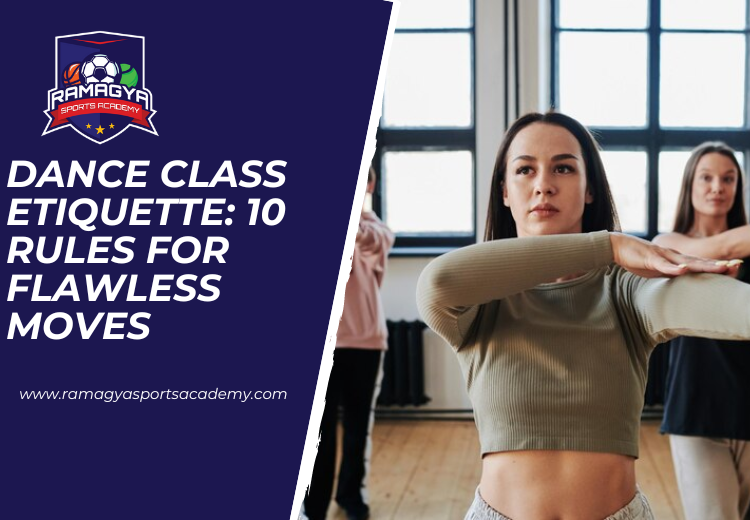
Stay Fit in this Winter: Expert Workout Tips for Cold Weather
June 1, 2024
Rabeeb Ali Khan Shines in AITA National Ranking Championship
June 5, 2024Dance Class Etiquette: 10 Rules for Flawless Moves
 Entering a dance studio is like entering into another realm. Movement serves as both an art form and language in this setting. Stepping into a dance studio is like entering an oasis, where movement transcends as mere steps to express our souls. Dance class etiquette serves as the unspoken language to guide every dancer towards harmony and mutual respect on the dance floor, regardless of experience level or performance ability. To navigate it gracefully, dance etiquette must be upheld in all classes – regardless if you are an experienced dancer or taking your first steps into this arena. By adhering to these ten simple rules, the dancing floor remains an ocean of creativity, discipline, and joy for everyone involved:
Entering a dance studio is like entering into another realm. Movement serves as both an art form and language in this setting. Stepping into a dance studio is like entering an oasis, where movement transcends as mere steps to express our souls. Dance class etiquette serves as the unspoken language to guide every dancer towards harmony and mutual respect on the dance floor, regardless of experience level or performance ability. To navigate it gracefully, dance etiquette must be upheld in all classes – regardless if you are an experienced dancer or taking your first steps into this arena. By adhering to these ten simple rules, the dancing floor remains an ocean of creativity, discipline, and joy for everyone involved:
- Arrive Early: Being on time ensures a smoother start to class without interfering with warm-ups or choreography sessions. It also demonstrates respect for yourself, your fellow dancers, and your instructor. Being early to class not only guarantees that you won’t miss any important directions or explanations, but it also demonstrates your commitment to improving as a dancer. You show that you are committed to improving your abilities and that you are prepared to put in the necessary time and effort by being on time. By arriving on time, a positive atmosphere is set among class members that allows for learning while providing enjoyment as well.
- Arrange Yourself Properly for Class: Being well prepared for dance class can help maximize your learning experience and honor both the instructor’s and other dancers’ efforts. To ensure the best class experience, this means wearing appropriate dance attire that allows for free movement and adhering to any dress codes set forth by your studio. In addition, make sure that you have all the necessary dance shoes and accessories, along with water for staying hydrated during class. Mental preparation is also vitally important. Arrive with an upbeat attitude, ready to fully engage in class activities and review previous material or choreography prior to classes to increase confidence and tackle new challenges with confidence. By arriving prepared, you demonstrate your dedication to making the most out of every moment spent in the studio, as well as contributing to an efficient and harmonious learning environment for everyone involved.
- Listening to Your Instructor: Paying close attention to your instructor is integral to both your growth as a dancer and the success of your class as a whole. Paying attention to their guidance, corrections, and instructions ensures you understand the material being taught effectively and can execute it successfully. Make eye contact, nod in acknowledgement of understanding, and ask any necessary questions if clarification is required. Doing this demonstrates respect for their expertise and dedication to your growth as a student. To avoid disruptions ensure maximum engagement with your instructor, avoid distractions by making eye contact, nodding in confirmation and asking any pertinent queries when necessary. Don’t forget that your instructor is there to assist in helping you reach your potential and progress, so trust their expertise and follow their direction with an open mind and willingness to learn. Listening carefully and taking their lead not only increases your dance etiquette capabilities but also fosters an enjoyable class environment where all can thrive.
- Respect Your Space: Ensuring a safe and conducive learning and practicing environment requires being conscious of one’s movements and spatial awareness in the dance studio in order to avoid collisions or disruptions between dancers. This can include being aware of any movements made that might collide with those around them and becoming disruptive to other dancers. Always place your belongings in designated areas and don’t scatter them around the studio, which could create hazards and clutter. Furthermore, be aware of your dance floor boundaries to prevent invading other dancers’ personal space. Respect any equipment or props provided by the studio by taking care to handle and return them after use. By showing consideration for both space and resources within it, you contribute to an atmosphere that encourages everyone involved to focus solely on training while enjoying every moment of their dance experience.
- Stay Complimentary: Showing encouragement to fellow dancers is essential to creating an inspiring dance etiquette class environment. Show your classmates your support during performances or when they master difficult steps by cheering loudly for them and offering words of encouragement and constructive feedback when appropriate, appreciating their efforts and progress. Be mindful and attentive during partner or group exercises, cooperating with others and offering assistance when needed. Avoid negative criticism or judgmental behavior, which may undermine confidence and disincentivize students from fully engaging with the class. Opt instead for teamwork and camaraderie by realizing the individual strengths of all dancers within your studio and being supportive of them all. Doing this creates a nurturing atmosphere where everyone feels valued, respected and encouraged to reach their full potential.
- Stay Concentrated: Staying concentrated during dance class is crucial to optimizing the learning experience and making the most of your studio experience. Try not to become distracted by checking your phone, engaging in side conversations, or letting your mind wander. These can all be distracting distractions that diminish learning experiences and lengthen studio visits. Instead, keep a tight focus on your instructor and the material being taught, taking in every nuance and detail of the choreography or technique taught. Attend classes attentively throughout, even during repetitive or review segments. There is always something new to learn or improve upon. Showing respect for your instructor, fellow dancers, and the art form demonstrates your etiquettes. Take each moment in class as an opportunity for growth and improvement by immersing yourself fully into dance practice – immerse yourself fully in movement’s joy!
- Maintain Good Hygiene: Upholding good hygiene is not only necessary for personal comfort but is also an act of respect towards other dancers and the studio environment. Before attending dance class:
- Ensure that you are clean and fresh by showering or using deodorant.
- Bring along clean dance attire and bring a towel for wiping away sweat during breaks.
- Keep your dance shoes free from any unpleasant odors or perfumes, which could distract others or cause allergies in others. If you are feeling under the weather or suffering from a contagious illness, consider staying home to avoid spreading germs to others.
- Pay close attention to personal grooming habits like nail trimming and hair tying, as this will prevent injuries during class and reduce distractions. By practicing good hygiene, you contribute to creating an inviting and clean studio atmosphere and allow everyone involved in dance etiquette practice to concentrate fully on enjoying themselves!
- Keep an open mind when receiving feedback: Incorporating feedback from both your instructor and peers as valuable opportunities to refine your technique and increase performance is integral to personal and artistic growth as a dancer. React appropriately when receiving feedback without becoming defensive or taking it personally, remembering that its purpose is to assist your growth. Be open-minded to suggestions for adjustments or corrections offered by others and ready to implement these into your practice. Engage with feedback proactively by seeking clarification or guidance when necessary, as well as actively soliciting the opinion of others regarding areas in which improvement may be needed. By showing humility and an eagerness to learn from feedback, you will not only accelerate your dancer’s development faster, but you will also contribute to an environment of mutual support within the dance community.
- Respect Personal Boundaries: Recognizing and respecting personal boundaries are an integral component of creating an atmosphere conducive to safe dance studio practice. Be mindful of other dancers’ personal space while staying away from invading it without their express permission. When doing dancing routines or exercises, take care to avoid making physical contact with others and always get permission before doing so. You should be mindful of your peers’ emotional limits and avoid making improper or intrusive remarks about their personal lives, abilities, or attractiveness. Treat everyone with kindness, empathy, and respect in all of your encounters. Be nice, considerate, and courteous. Respecting your limits fosters a culture of trust among dance etiquette communities, which empowers all participants to express themselves fully via dance.
- Make Sure You Enjoy Dancing: Above all else, remember to enjoy yourself while dancing! Dancing can be a joyful way of expressing movement and emotion, so take full advantage of all that dance offers by engaging fully with music, choreography, and fellow dancers while remaining positive and enthusiastic! Allow yourself to let go of inhibitions and self-doubt and fully immerse yourself in the joy of dancing. Don’t be embarrassed to laugh at yourself or make mistakes; that’s part of learning! Be proud of every small triumph and milestone achieved, such as mastering an unfamiliar step or experiencing music through your body. Celebrate every small success and success. Attracting dance classes with an atmosphere of fun and playfulness not only increases your enjoyment but also contributes to creating a lively and joyful studio space. So let go of any inhibitions, express yourself freely, and dance from the heart!
Conclusion:
Etiquette in dance is more than just rules; it demonstrates respect for art, instructors and fellow dancers. By adhering to these ten simple guidelines, dancers contribute to creating an uplifting and supportive environment where everyone can flourish. Let us honor dance traditions by including etiquette as part of our practice, ensuring every class not only offers lessons in technique but also builds camaraderie and mutual esteem between dancers. As we leave our dance studios behind us, let us remember the lessons of etiquette we learned there. May our dedication to dance class etiquette demonstrate our respect for the art form while building an inclusive community that upholds one another both on and off the dance floor.Read our Article: Art of Dance: The Universal Language of Expression



